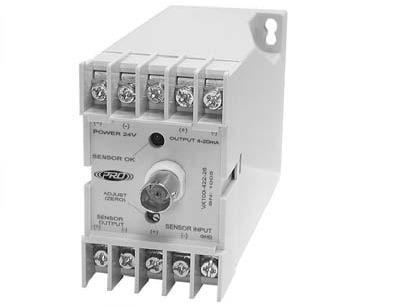SC101 Signal Conditioners

Continuous monitoring may be needed in order to identify these transient faults to ensure the equipment will continue to perform as needed. The early fault identification can then allow time for a corrective action to be developed and implemented at a schedule downtime, rather than having to disrupt operations for a failure.
PRO signal conditioners accept the vibration signal from an accelerometer and convert it to a 4-20 mA proportional output to the overall vibration (either in Peak or RMS - customer specified). Band pass filters can be specified to narrow the desired frequency range in order to focus on specific faults, if desired. The output can interface with a PLC or DCS system, which in turn can continuously monitor the health of the machine. This allows for alarming and trending of the machine condition. Some systems can even be programmed to shutdown the
equipment (either manually by an operator or through the PLC or DCS).
Although this output is proportional to the overall vibration limit of the machine in the frequency range specified, the analog signal from the accelerometer can also be accessed through the BNC connector or a terminal strip on the signal conditioner. This option allows the analyst to perform diagnostic analysis on the machine fault as well as providing the continuous, overall monitoring and periodic, diagnostic monitoring.
Specifications
- Maximum Load Resistance: 600 Ohms
- Humidity Range: 0-95% Relative, Non-Condensing
- Connectors: Screw Terminal Contacts
- Max Frequency Response: 2 Hz to 20,000 Hz +3 dB
- Power: 24 to 32 VDC Unregulated/100 mA Nominal.
- This powers the accelerometer through the transmitter
- Isolation: 200 VDC Minimum
- Ambient Temperature: -40 C to +80 C
- Weight: 6.4 Ounces (181,44 g)
